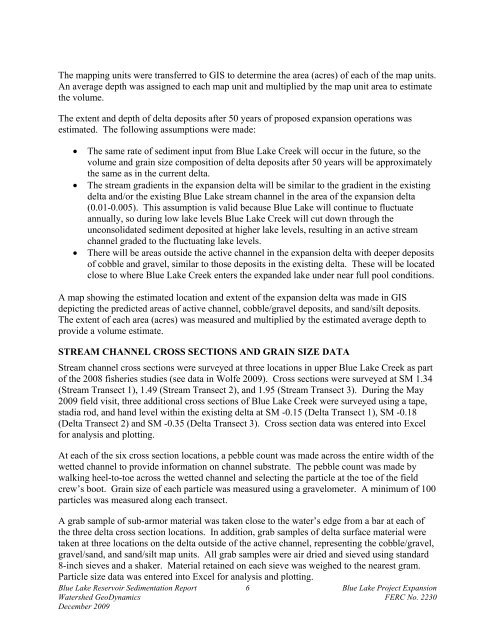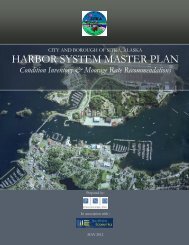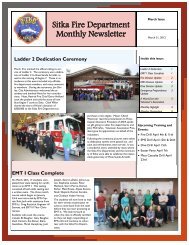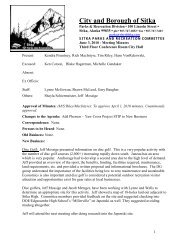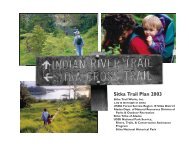final Sedimentation Report - City and Borough of Sitka
final Sedimentation Report - City and Borough of Sitka
final Sedimentation Report - City and Borough of Sitka
You also want an ePaper? Increase the reach of your titles
YUMPU automatically turns print PDFs into web optimized ePapers that Google loves.
The mapping units were transferred to GIS to determine the area (acres) <strong>of</strong> each <strong>of</strong> the map units.<br />
An average depth was assigned to each map unit <strong>and</strong> multiplied by the map unit area to estimate<br />
the volume.<br />
The extent <strong>and</strong> depth <strong>of</strong> delta deposits after 50 years <strong>of</strong> proposed expansion operations was<br />
estimated. The following assumptions were made:<br />
• The same rate <strong>of</strong> sediment input from Blue Lake Creek will occur in the future, so the<br />
volume <strong>and</strong> grain size composition <strong>of</strong> delta deposits after 50 years will be approximately<br />
the same as in the current delta.<br />
• The stream gradients in the expansion delta will be similar to the gradient in the existing<br />
delta <strong>and</strong>/or the existing Blue Lake stream channel in the area <strong>of</strong> the expansion delta<br />
(0.01-0.005). This assumption is valid because Blue Lake will continue to fluctuate<br />
annually, so during low lake levels Blue Lake Creek will cut down through the<br />
unconsolidated sediment deposited at higher lake levels, resulting in an active stream<br />
channel graded to the fluctuating lake levels.<br />
• There will be areas outside the active channel in the expansion delta with deeper deposits<br />
<strong>of</strong> cobble <strong>and</strong> gravel, similar to those deposits in the existing delta. These will be located<br />
close to where Blue Lake Creek enters the exp<strong>and</strong>ed lake under near full pool conditions.<br />
A map showing the estimated location <strong>and</strong> extent <strong>of</strong> the expansion delta was made in GIS<br />
depicting the predicted areas <strong>of</strong> active channel, cobble/gravel deposits, <strong>and</strong> s<strong>and</strong>/silt deposits.<br />
The extent <strong>of</strong> each area (acres) was measured <strong>and</strong> multiplied by the estimated average depth to<br />
provide a volume estimate.<br />
STREAM CHANNEL CROSS SECTIONS AND GRAIN SIZE DATA<br />
Stream channel cross sections were surveyed at three locations in upper Blue Lake Creek as part<br />
<strong>of</strong> the 2008 fisheries studies (see data in Wolfe 2009). Cross sections were surveyed at SM 1.34<br />
(Stream Transect 1), 1.49 (Stream Transect 2), <strong>and</strong> 1.95 (Stream Transect 3). During the May<br />
2009 field visit, three additional cross sections <strong>of</strong> Blue Lake Creek were surveyed using a tape,<br />
stadia rod, <strong>and</strong> h<strong>and</strong> level within the existing delta at SM -0.15 (Delta Transect 1), SM -0.18<br />
(Delta Transect 2) <strong>and</strong> SM -0.35 (Delta Transect 3). Cross section data was entered into Excel<br />
for analysis <strong>and</strong> plotting.<br />
At each <strong>of</strong> the six cross section locations, a pebble count was made across the entire width <strong>of</strong> the<br />
wetted channel to provide information on channel substrate. The pebble count was made by<br />
walking heel-to-toe across the wetted channel <strong>and</strong> selecting the particle at the toe <strong>of</strong> the field<br />
crew’s boot. Grain size <strong>of</strong> each particle was measured using a gravelometer. A minimum <strong>of</strong> 100<br />
particles was measured along each transect.<br />
A grab sample <strong>of</strong> sub-armor material was taken close to the water’s edge from a bar at each <strong>of</strong><br />
the three delta cross section locations. In addition, grab samples <strong>of</strong> delta surface material were<br />
taken at three locations on the delta outside <strong>of</strong> the active channel, representing the cobble/gravel,<br />
gravel/s<strong>and</strong>, <strong>and</strong> s<strong>and</strong>/silt map units. All grab samples were air dried <strong>and</strong> sieved using st<strong>and</strong>ard<br />
8-inch sieves <strong>and</strong> a shaker. Material retained on each sieve was weighed to the nearest gram.<br />
Particle size data was entered into Excel for analysis <strong>and</strong> plotting.<br />
Blue Lake Reservoir <strong>Sedimentation</strong> <strong>Report</strong> 6 Blue Lake Project Expansion<br />
Watershed GeoDynamics FERC No. 2230<br />
December 2009


